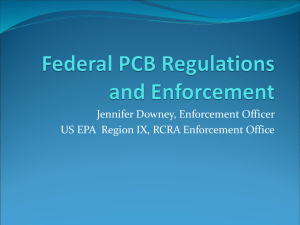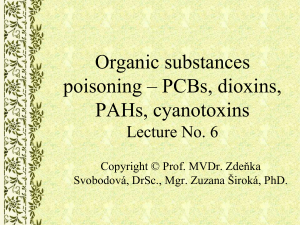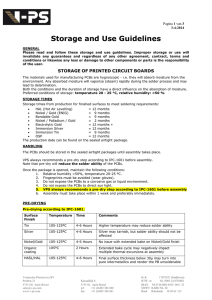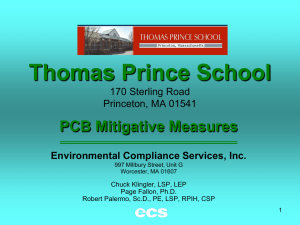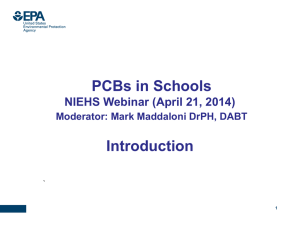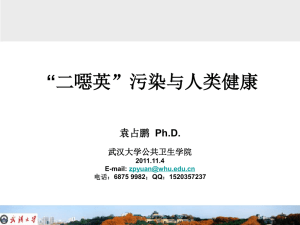Eichstaedt - Spokane River Forum
advertisement
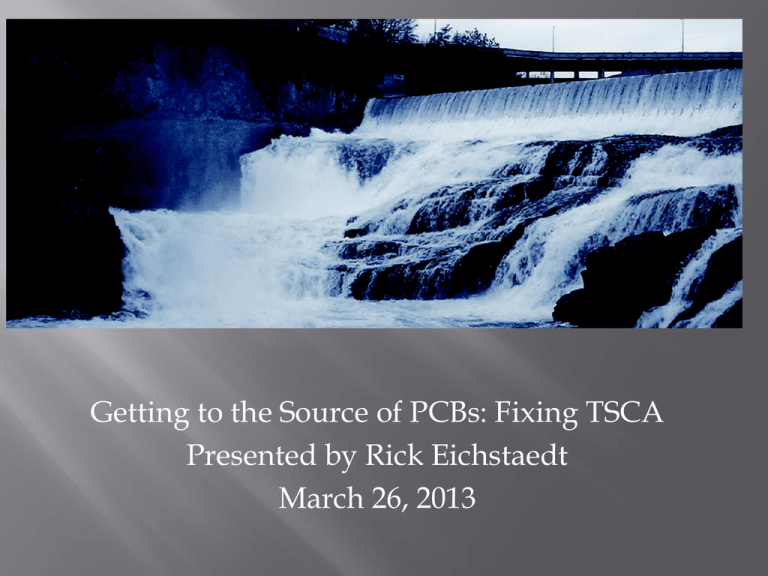
Getting to the Source of PCBs: Fixing TSCA Presented by Rick Eichstaedt March 26, 2013 209 congeners Congeners differ in Abundance Physical properties Biological effects Aroclors are mixtures of congeners Attach to sediment particles Significant human health and environmental effects 1865 --- First PCB-like chemical discovered; a by-product of coal tar (chimney sweeps). 1927 --- PCBs were first manufactured commercially by the Anniston Ordnance Company, in Anniston, Alabama. 1936 - Scientists issued a report attributing workers’ disease symptoms. 1937 --- A study published in the Journal of Industrial Hygiene and Toxicology suggested links between PCBs and liver disease. 1947 --- GE began using PCBs in the manufacture of electrical equipment. 1970 --- Annual U.S. production peaked with 85 million pounds of PCBs produced. 1973 --- U.S. Food and Drug Administration establishes a tolerance level of 5.0 parts per million (ppm) in fish. 1976 --- Congress passed the Toxic Substances Control Act. 1977 --- Monsanto stopped manufacturing PCBs in the U.S. 1979 --- EPA issued final regulations banning the manufacture of PCBs. Between 1930 and 1970, approximately 30,000 tons were released to air, 60,000 tons to fresh and coastal waters, and 300,000 tons to dumps and landfills. Waters and their sediments contaminated by PCBs have resulted in over 675 advisories restricting the consumption of PCB-contaminated fish, shellfish, and wildlife issued in 37 states and in one U.S. Territory (American Samoa). 5,578 waterbodies on 303(d) list for PCBs. Washington State 170 pg/l (parts per quadrillion) in water Translates to 5.3 ppb (parts per billion) for fish tissue Spokane Tribe 3.37 pg/l in water Translates to 0.1 ppb for fish tissue Source control strategies generally fall into four different categories: Technology-based Strategies Local Regulatory Strategies Public and Business Outreach Regional, National, or International Strategies. Specific to PCBs: Controls the manufacturing, processing, distributionin-commerce, use, marking and disposal of PCBs Bans manufacturing and processing, unless exempted by rule: Exempted Manufacturing Processes (EMPs) Exempted PCB Products (EPPs) Distribution of intact, non-leaking electrical equipment is totally enclosed Bans distribution, except for totally enclosed and authorized PCBs Bans use/storage, unless authorized by rule: Use/storage authorized > 50 ppm for certain electrical equipment and other uses (e.g., carbonless copy paper; research and development; natural gas pipelines; porous surfaces contaminated by spills; decontaminated materials) Recycling paper and asphalt shingles Disposal – PCBs > 50 ppm and remediation (cleanup) wastes, options include: TSCA-permitted incinerator; high-efficiency boilers (liquids < 500 ppm); TSCA-permitted landfills (solids); permitted alternative destruction technologies; scrap metal recovery ovens (metals <500 ppm); decontamination; risk-based disposal Manufacturing exemptions: Inadvertently generated PCBs, annual average <25 ppm; 50 ppm max Notification to EPA if >2 ppm Approximately 72 notices from 28 companies on file Use exemptions: No authorization is needed to use excluded PCB products, products of an excluded manufacturing process, recycled PCBs, or sewage sludge Processing and distribution in commerce allowed for: Excluded PCB products, recycled PCBs Combination of carbon, chlorine, and high temperatures can result in PCB generation. Up to 200 chemical processes may create PCB byproducts. Products inadvertently containing PCBs include paint, inks, ag chemicals, plastics, and detergent. Source: EPA PCB TMDL Handbook. EPA solicited comments and data needed to characterize/understand ongoing sources and releases of PCBs: Liquid PCBs in equipment and pipelines Elimination of most use authorizations at levels ≥ 50 ppm Non-liquid PCBs (including caulk) Porous surfaces with PCBs Definitional and marking issues Use of 50 ppm level for excluded products Notice of Proposed Rulemaking projected to July 2014. 242 comments in docket; about 148 individual commenters Major groups of commenters Electrical utilities (industry) Natural gas transmitters and distributors (e.g., INGAA, AGA) Parents and workers in New York City schools (caulk) Governments (DOE, Mass. DEP) Recycled paper producers (Inland Paper) Pigment Manufacturers (Color & Pigment Manufacturers Ass’n) Metal/plastic recyclers (e.g., ISRI, MBA Polymers) Environmental groups (Riverkeeper, TLC) Inland Empire Paper/Spokane Riverkeeper/The Lands Council Eliminate all federal exclusions or exceptions for inadvertently formed PCBs as a byproduct or impurity in chemical manufacturing processes Northwest Pulp and Paper Association (NWPPA) NWPPA supports lowering the allowable concentration of PCBs in dyes, inks and pigments products as much as possible, using a phased approach, as the best mechanism for reducing PCB contamination in recycled furnish Such action must be coordinated and connected federal and state actions involved in developing water quality criteria and implementation American Forest and Paper Association (AF&PA) Carbonless copy paper manufactured in the U.S. no longer contains PCBs; AF&PA encourages EPA to discontinue use authorization for PCBs in manufactured/imported carbonless copy paper PCBs in azo and phthalocyanine pigments should be banned from U.S. commerce, including imported products and packaging Washington State Department of Ecology Significant amounts of PCBs flow into Puget Sound; primary source is runoff; “ . . . do not have estimate for which sources of PCBs are contributing most to loading” Does not “recommend that the EPA authorize the use of caulk, paint, or other non-liquid PCB product at concentrations exceeding the level of 50 ppm currently provided . . . for excluded PCB products” California Regional Water Quality Board “In development of this TMDL, we learned that PCBs releases from uncontained spills and outdated products are the largest ongoing sources of PCBs in our waterways” (e.g., caulk, paint, other building materials) Consider water quality impacts when reducing the exclusion concentration for PCBs Confederated Tribes of the Umatilla Indian Reservations (CTUIR) “CTUIR DNR supports the elimination of PCBs from all dyes, pigments and inks” Overseas manufacturers send products to U.S. and U.S. companies must clean up contamination to meet water quality standards Color Pigment Manufacturers Association (CPMA) 1 ppm threshold would eliminate three important pigment groups from commerce, affecting color printing as well as colors in paint and plastics Technology does not now exist to eliminate PCBs in all organic pigments to a level below 1 ppm Would put U.S. pigment and product manufacturers at additional competitive disadvantage versus pigment and product importers Representative Mike Simpson (Idaho) letter to EPA EPA regulations inequitably allow overseas manufacturers to export PCB containing products into the U.S. with concentrations up to 50 ppm, while then subjecting our own businesses and communities to surface water quality standards that are nearly 8 million times more stringent Manufacturing alternatives for similar dyes and pigments that do not contain PCBs are available “On behalf of the American people and the protection of our environment, I request that your agency make the common-sense decision to revise all appropriate sections of the TSCA regulations that allow imported products to contain PCBs.” ECOS: national non-profit, non-partisan association of state and territorial environmental agency leaders. August 2012: passed a resolution addressed to the EPA that laid out several points about how to best address levels of PCBs in wastewater discharges to our nation's waterbodies: Called for EPA, industry, and states to work together on alternatives to chlorinated solvents used in pigment and ink manufacturing to develop manufacturing processes in the next five years that do not generate PCBs. Called for National approach to the problem of inadvertently created PCBs in inks and pigments. Supported EPA's proposed rulemaking to reassess the current use authorizations for PCBs, which includes products with PCBs less than 50 ppm and inadvertently generated PCBs in products at less than 25 ppm. EPA should move forward with this rulemaking to better protect human health and the environment. Recommended that EPA continue its efforts reduce PCBs and work with the international community on the elimination of PCBs. March 1, 2013 article in Environmental Health Perspectives. “The EPA’s Design for the Environment Program, which is conducting alternative assessments on various chemical products, is not currently involved in any research on pigments. That the EPA initiate such research is one of the recommendations put forth in the ECOS resolution. As rulemaking continues for the EPA’s reassessment of current PCB regulations, an EPA spokeswoman provided no information on the status of the agency’s ongoing assessment of non-dioxinlike health effects of PCBs.” EPA’s default fish consumption rates are 17.5 g/day for adults in the general population. 142.4 g/day for subsistence fishers. Oregon’s new standard: 175 g/day. EPA rejected Idaho’s use of 17.5 g/day. Spokane Tribe: 86.6 g/day now , proposed 865 g/day.
